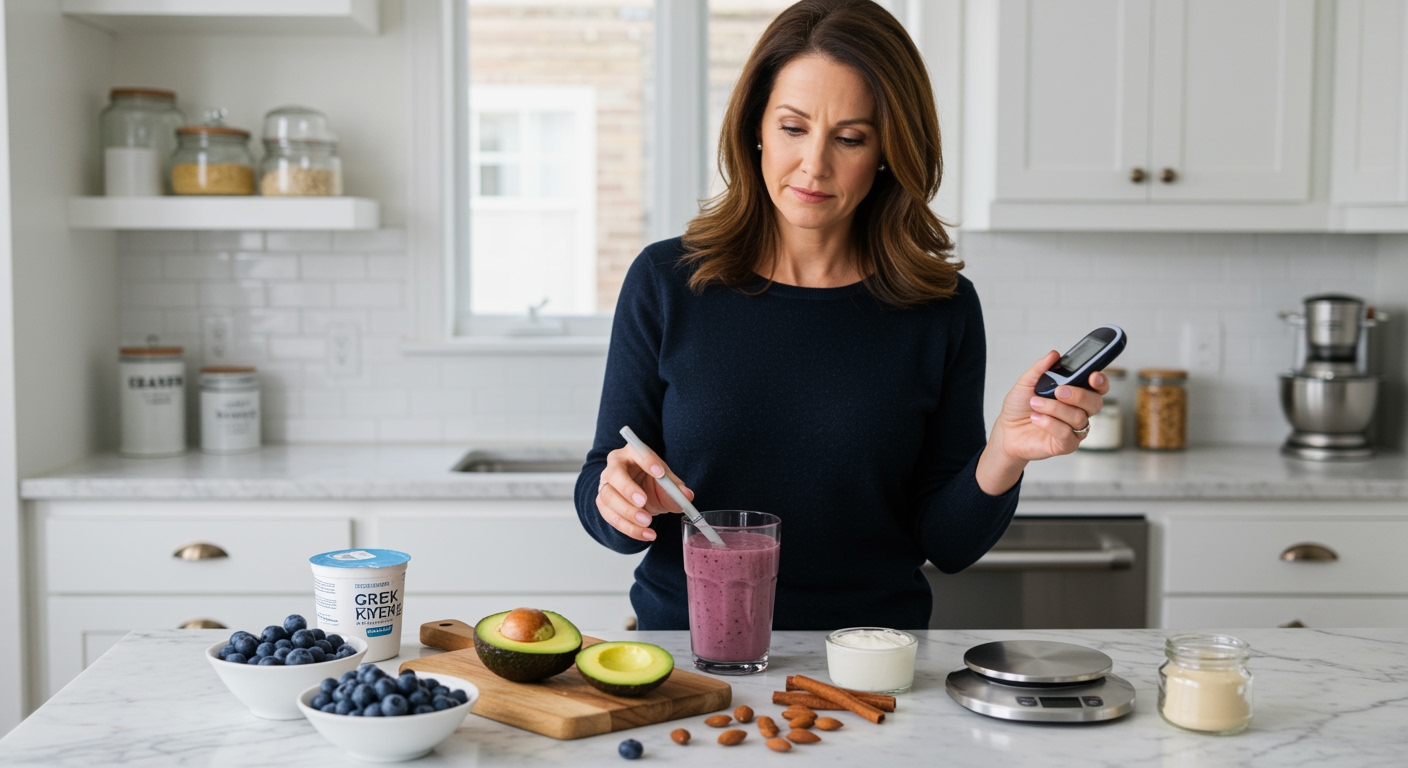✪ Key Takeaway: Fruit smoothies can be safe for diabetes when made with low-glycemic ingredients and proper portion control.
Introduction
Your doctor just told you that you have diabetes, and now you are staring at your favorite mango smoothie wondering if those days are over forever.
You might be asking this question because you love smoothies but worry they will send your blood sugar through the roof, or maybe someone told you that all fruit is off-limits now.
Hi, I am Abdur, your nutrition coach, and today I am going to explain exactly how fruit smoothies affect your blood sugar and show you how to make them diabetes-friendly.
How Do Fruit Smoothies Affect Blood Sugar?
Fruit smoothies can cause rapid blood sugar spikes because blending breaks down the fruit’s fiber structure.
When you blend fruit, you are essentially pre-digesting it for your body.
The natural sugars in fruit get absorbed much faster when the fiber is broken down through blending.
This means your blood sugar can rise within 15 to 30 minutes after drinking a fruit smoothie.
Research shows that smoothies cause higher blood sugar peaks compared to eating whole fruits.
The glycemic response from a smoothie can be 30 to 50 percent higher than eating the same fruits whole.
However, this does not mean you have to give up smoothies completely if you have diabetes.
✪ Fact: Blending fruit increases sugar absorption speed by up to 40 percent compared to whole fruit.
Which Smoothie Ingredients Spike Blood Sugar?
High-sugar fruits like mangoes, pineapples, and bananas are the biggest culprits for blood sugar spikes in smoothies.
These fruits contain high amounts of natural sugars that get absorbed quickly when blended.
Added sweeteners like honey, agave, or maple syrup make the problem even worse.
Many people add these thinking they are healthier than regular sugar, but your body processes them the same way.
Fruit juices used as a base instead of water or unsweetened milk also contribute to rapid blood sugar rises.
Even 100 percent fruit juice contains concentrated sugars without the beneficial fiber found in whole fruits.
Large portion sizes turn even moderate-sugar fruits into blood sugar bombs when you use two or three servings in one smoothie.
✪ Pro Tip: One medium banana contains about 14 grams of sugar, equivalent to 3.5 teaspoons of table sugar.
What Makes A Smoothie Diabetes-Friendly?
Low-glycemic fruits like berries, green apples, and small amounts of citrus fruits form the foundation of diabetes-friendly smoothies.
These fruits contain less sugar and more fiber, which helps slow down sugar absorption.
Adding protein sources like Greek yogurt, protein powder, or nut butter helps stabilize blood sugar by slowing digestion.
Protein also helps you feel full longer, preventing the urge to snack on high-sugar foods later.
Healthy fats from avocado, nuts, or seeds work similarly to protein by slowing sugar absorption.
These fats also provide essential nutrients and help create a creamy texture without added sugars.
Using fiber-rich vegetables like spinach or cauliflower adds bulk and nutrients without significantly impacting blood sugar.
✪ Note: Adding 15 grams of protein to a smoothie can reduce blood sugar spikes by up to 25 percent.
How Should You Time Your Smoothie Consumption?
Morning consumption works best for most people with diabetes because your body is more insulin sensitive after fasting overnight.
This means your body can handle the natural sugars in fruit more effectively in the morning.
Drinking smoothies after exercise is another optimal time because physical activity increases insulin sensitivity.
Your muscles are also more likely to use the sugar for recovery rather than storing it as fat.
Avoid smoothies late in the evening when your insulin sensitivity naturally decreases.
Evening consumption can lead to higher and longer-lasting blood sugar elevations.
Consider having your smoothie as a meal replacement rather than a snack to better control total carbohydrate intake throughout the day.
✪ Fact: Insulin sensitivity can be up to 50 percent higher in the morning compared to evening hours.
What Portion Size Works For Diabetes?
A diabetes-friendly smoothie should contain no more than 15 to 30 grams of total carbohydrates.
This typically translates to about 8 to 12 ounces of finished smoothie, depending on the ingredients used.
Limit fruit portions to one serving per smoothie, which equals about half a cup of berries or one small apple.
Using measuring cups instead of eyeballing portions helps you maintain consistent carbohydrate intake.
Balance your smoothie with 2 to 3 tablespoons of protein powder or Greek yogurt and 1 tablespoon of healthy fats.
This ratio helps create a more balanced macronutrient profile that supports stable blood sugar.
Monitor your blood sugar 1 to 2 hours after drinking your smoothie to understand how your body responds to different ingredient combinations.
✪ Pro Tip: Keep a smoothie journal to track which combinations work best for your blood sugar control.
The Bottom Line
Fruit smoothies can absolutely be part of a diabetes-friendly diet when you make smart ingredient choices and control portions.
The key is not to avoid smoothies completely, but to make them work for your blood sugar goals.
I would love to hear about your experience with smoothies and diabetes management, so please share your questions or favorite diabetes-friendly smoothie recipes in the comments below.
References
At NutritionCrown, we use quality and credible sources to ensure our content is accurate and trustworthy. Below are the sources referenced in creating this article:
- Nutrition Facts: Do Smoothies Cause Overly Rapid Sugar Absorption?
- PMC: Effects of Fruit and Vegetable Smoothies on Glycemic Response
- Utah State University: Smoothies: Helpful or Harmful
- Prevention: Blood Sugar Friendly Smoothie Ingredients





